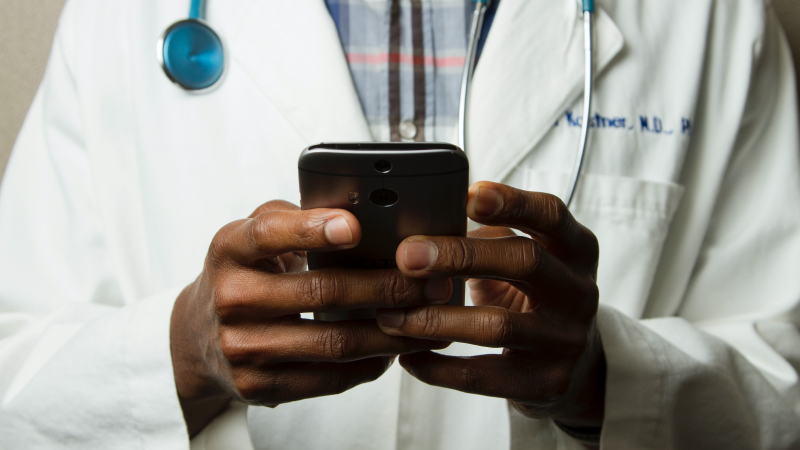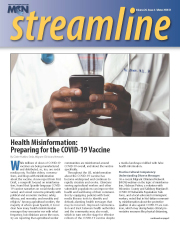
While millions of doses of COVID-19 vaccines are being manufactured and distributed, so, too, are social media posts, YouTube videos, conversations, and blogs with misinformation about the vaccine. A new report from First Draft, a nonprofit focused on misinformation, found that Spanish-language COVID-19 vaccine narratives on social media were varied, and voiced concerns primarily with political and economic motives; safety, efficacy, and necessity; and morality and religion.1 Among agricultural workers, the majority of whom speak Spanish, it is not clear how many health misinformation messages they encounter nor with what frequency, but clinicians across the country are reporting that agricultural worker communities are misinformed around COVID-19 overall, and about the vaccine specifically.
Throughout the US, misinformation about the COVID-19 vaccine has become widespread and continues to rapidly circulate and evolve. Clinicians serving agricultural workers and other vulnerable populations can improve the health and well-being of their communities by equipping patients with basic media literacy tools to identify and debunk alarming health messages that may be incorrect. Improved communication and trust between health authorities and the community may also result, which in turn sets the stage for effective rollouts of the COVID-19 vaccine despite a media landscape riddled with false health information.
Practice Cultural Competency: Understanding Diverse Messages
On a recent Migrant Clinicians Network (MCN) webinar on the topic of misinformation, Habacuc Petion, a volunteer with Wicomico County and Salisbury Maryland’s COVID-19 Vulnerable Populations Task Force, and a local advocate for immigrant workers, noted that in his Haitian community, misinformation about the protective qualities of aloe against COVID-19 are common, which may deemphasize critical preventative measures like physical distancing, mask use, and hand washing. In North Carolina, Gayle Thomas, MD, medical director of the North Carolina Farmworker Health Program, found that her agricultural worker patients resisted going to the hospital, as rumors had spread that those who go to the hospital never recover. While this concern is rooted in truth – those sick enough to go to the hospital have a higher rate of death – the consequence of the rumor may be avoidance of care while sick with COVID-19, which may drive the death rate even higher. Both incidents point to individual communities’ unique approaches to and concerns about the pandemic – and the related misinformation that is spawned from those concerns -- which require clinicians to both anticipate the community’s reactions and to work to meet those concerns.
Most agricultural workers are Spanish-speaking, and nationwide, in First Draft’s recent analysis, COVID-19 vaccine misinformation in Spanish-language social media was mostly categorized in “political and economic motives,” reflecting mistrust in government bodies providing a safe vaccine. The report points out that confidence in national governments is low in Latin America, potentially contributing to this narrative. Increasing anti-immigrant policies and commentary, coupled with a history that includes government-sponsored medical research such as the Tuskegee Syphilis Study and the involuntary sterilization of poor, limited-English-proficient women as experienced by the Madrigal 10, have created confusion and fear within immigrant communities. A resurgence of historical trauma and distrust is occurring especially as migrant and seasonal agricultural workers are being prioritized for the fast-tracked federally sponsored COVID-19 vaccine in some area.
Language Presentation and Message Access
In December, Eva Galvez, MD, MCN’s Board Chair and a family physician at Virginia Garcia Memorial Health Center in Hillsboro, Oregon, told National Public Radio (NPR) Morning Edition that “the information that we’re reading in different media platforms is often not in a language or [at a] literacy level that my patients can understand.” She added, “When people don’t have access to accurate information, they rely on other platforms – word of mouth, social media – and those are often not accurate.”
Heather Kathrens, Refugee Mental Health Coordinator for the Maryland Department of Health’s Center for Global Migration and Immigrant Health, similarly emphasizes that language is key. Kathrens works closely with refugee populations through the health department. “What I see is a lack of professionally translated information,” Kathrens said. “At the health department, we constantly urge people to go to trusted sites,” like the Centers for Disease Control and Prevention (CDC) or World Health Organization (WHO), but many of those sites lack translated information in the languages they need, she said. When critical messages are translated, it is often only in Spanish. “Are we doing it in Spanish, when really the community is mainly Haitian Creole? … When it’s a Korean neighborhood? It’s really [about] knowing your community,” she added. Notably, some agricultural workers from Latin America may speak an indigenous language as their first language, and Spanish as a second language, communicating in Spanish but with a lack of fluency that may reduce their understanding of complex health messages. As contact tracing and vaccination efforts expand, well-translated and low-literacy health information in all the languages represented in the community is critical.
Once the information is translated, then efforts must continue to get this information out. Among agricultural worker communities, with minimal access to the internet, local newspapers, or television news, and little integration with local rural communities, local radio shows may be one of the only sources of news, beyond word of mouth and some social media. Federico Subervi-Vélez, PhD, media and communications expert and Honorary Associate/Fellow of Latin America, Caribbean, and Iberian Studies at the University of Wisconsin-Madison, encourages community health centers to partner with local radio to provide health messages from local trusted health authorities like clinicians directly to the community through radio. Dr. Subervi-Vélez noted that in the US, "Spanish-language radio, for the most part, does not provide much of any news – and that’s one of the problems.” MCN’s recent public service announcements in Spanish may assist local communities; each short announcement provides basic health information about COVID-19 in a template form. Local communities can download and tailor the public service announcements (PSAs) to their own community. (See resources for links to the PSAs).
How Clinicians Can Combat Misinformation from the Health Center
“More thinking than liking.” That is the summary of Dr. Subervi-Vélez’s personal approach when encountering a health message on social media. “Take the time to get information and to check the sources of your information before you get alarmed,” he added. Because of poor communication on the national level, including from top leaders; a growing mistrust in traditional print media; and the increase of reliance on social media as a news source, individuals find themselves vetting health information on their own, rather than rely on media authorities to do the vetting for them. Vaccines are now a hot-button issue, one that was largely settled as a safe and effective health intervention just 10 years ago. The introduction of uncertainty around vaccination in the last decade fueled by social media with the rise of the “anti-vax” movement, layered over the wildly varying health misinformation about COVID-19 overall, may further sow distrust and anxiety among those who are eligible for the vaccine.
MCN’s new resource, “Deconstructing Health Messages,” guides a person who has encountered a health message to identify and evaluate its accuracy and authenticity. Clinicians can share the interactive tool or print out the one-page abbreviated version to hand out in the clinic. Clinicians can affirm the underlying emotions that drive the response to misinformation – fear, anxiety, anger – and reinforce basic accurate health messages. The interactive version of the tool presents five primary questions to ask about a health message, developed by the Center for Media Literacy, around authorship, format, audience, content, and purpose. Each of those questions are accompanied by related resources that are tailored to immigrant and migrant audiences like agricultural workers. Authorship, for example, is paired with a reverse image search tool and a WhatsApp Health Alert offered by the World Health Organization; WhatsApp is a popular platform among immigrants in the US for communicating with family members in home countries, and may be more utilized than other common platforms like Facebook. (See resources, below.) Clinicians can empower patients with basic media literacy through these tools.
Bigger Picture: Reducing the Effect of Misinformation
Data deficits on COVID-19 due to the short timeframe in which the virus has spread, coupled with inconsistent and conflicting messaging from state and government sources, may have contributed to the rise of misinformation around COVID-19. Both concerns may be shifting. As we enter the second year of the pandemic, researchers have a better grasp on the mechanics of the virus, and approved vaccines have testing phase research and early track records as they have been rolled out. Using that research, the new administration has an opportunity to get ahead of misinformation with solid, consistent, and reliable health information. But “it’s not just at the top where it’s imperative,” insists Dr. Subervi-Vélez. “It’s also from senators, from governors, from local state senators and representatives, from city council people.” Local media, he adds, has the obligation to pass on these health messages to communities. He warns that misinformation will continue to be rehashed but “great quality messaging, all the way down to local officials and medical staff” will be key in shifting the narrative toward science. Clinicians, while not media experts, are trusted local authority figures with specialized knowledge in their fields, who can help patients and the community as a whole to prioritize science-based health messages to ensure the COVID-19 vaccine rollout is successful.
Access MCN’s resource, Deconstructing Health Messages: Five Key Questions as a handout and as an interactive online tool, along with its associated resources related to each question, at: https://bit.ly/3lVxcGL
Watch the archived webinar on health misinformation in English here: https://bit.ly/36XgSRJ
Watch the archived webinar on health misinformation in Spanish here: https://bit.ly/37KiZaS
Access MCN’s public service announcements on COVID-19, in Spanish, here: https://bit.ly/3oDxlkb
You can see how other communities have used these PSAs by listening to one community’s tailored PSAs here: https://bit.ly/37RTWCS
Read this article in the Winter 2021 issue of Streamline here!
Sign up for our eNewsletter to receive bimonthly news from MCN, including announcements of the next Streamline.
